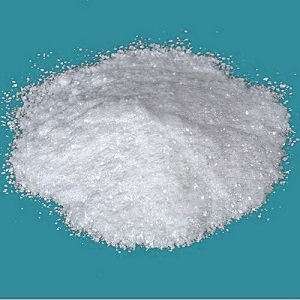| Description | Lithium iodide (chemical formula: LiI) is the compound of lithium and iodine. It can be used as an electrolyte in high-temperature batteries, long-life batteries which is required, e.g. by artificial pacemaker as well as in the electrolyte of dye-sensitized solar cells. In organic synthesis, it can be used for C-O bonds cleavage such as converting methyl esters to carboxylic acids. In addition, it can be used as a radio contrast agent for X-ray computed tomography imaging studies.

|
| Physical properties | Lithium iodide, a white crystalline solid, is deliquescent as are lithium chloride and lithium bromide. Lithium iodide is readily oxidized in air to yield iodine which discolors the crystals.
Lithium iodide is very soluble in water and forms the following hydrates: Lii-0.5 H2O, L i l·O , LiI-2H20 and LiI·3H20. The hydrates have congruent melting points unlike the hydrates of the chloride and the bromide.
Lithium iodide is even more soluble in organic solvents than the chloride or the bromide.
|
| Uses | Lithium iodide can be used for the catalytic dehydrogenation of hydrocarbons. Oxidation of lithium iodide yields iodine which reacts with the hydrocarbon to form an organic iodide. The intermediate is dehydroiodinated to yield an olefin.For example, butane may be converted to butadiene. |
| Preparation | The laboratory preparation of lithium iodide is carried out in much the same way as the industrial preparation.
Lithium iodide is prepared by the reaction of lithium hydroxide monohydrate or lithium carbonate with hydriodic acid, which may be prepared in situ by the reduction of iodine. The iodide is usually not isolated as the anhydrous material but is used as a solution or as the solid lithium iodide trihydrate.
Hydriodic acid may be prepared by the reaction of hydrogen sulfide and iodine. The hydriodic acid solution must be kept under an inert atmosphere to prevent air oxidation to iodine. After combination of the acid with the lithium compounds, the solution may be evaporated to yield lithium iodide trihydrate, LiI· 3H20. The anhydrous material may be made by extremely careful dehydration of the trihydrate under vacuum and with slow heating. The lithium iodide or its trihydrate must be handled under an inert atmosphere to avoid oxidation of the iodide ion to iodine.
|
| References | http://en.wikipedia.org/wiki/Lithium_iodide
|
| Chemical Properties | White to off-white crystalline powder |
| Physical properties | White cubic crystals; refractive index 1.955; density 4.076 g/cm3; melts at 449°C; vaporizes around 1,180°C; highly soluble in water (165 g/100g at 20°C), solubility greatly increases in hot water (433g/100g at 80°C); also very soluble in methanol (343 g/100g at 20°C) and ammonia; soluble in acetone (42.6g/100g at 18°C).
The trihydrate, LiI?3H2O, is a yellowish solid (due to the release of iodine when exposed to air); hexagonal crystals; hygroscopic; density 3.48 g/cm3; loses iodine when heated in air; loses one molecule of water of crystallization at 73°C becoming dihydrate, LiI?2H2O and loses the second molecule at 80°C, forming monohydrate, LiI?H2O and becomes anhydrous at 130°C; highly soluble in water; soluble in ethanol and acetone. |
| Uses | Controls regioselectivity in palladium catalyzed allylic alkylation reactions.1 |
| Uses | It is used as a absorbent in refrigeration process, as a catalyst, and in photography. It is also useful for organic synthesis, pessat iodination, cleavage of esters, ethers, epoxides, decarboethoxylation, carbonylation, and aldol condensation. It is used for manufacturing medicines and mineral waters. It is used in electochemicstry and redox reactions. Lithium iodide is also a catalyzed conjugate addition reaction of β-dicarbonyl compounds. It is also useful for tetrathioquinodimethane. |
| Uses | Controls regioselectivity in palladium-catalyzed allylic alkylation reactions. |
| Preparation | The trihydrate salt is obtained by neutralization of lithium hydroxide or lithium carbonate solution with pure hydriodic acid followed by concentration of the solution for crystallization:
LiOH + HI → LiI + H2O
When heated in a vacuum, the trihydrate dehydrates to anhydrous salt. |
| Purification Methods | Crystallise it from hot water (0.5mL/g) by cooling in a CaCl2-ice EtOH or from an acetone-Dry-Ice bath. Dry it under a vacuum over P2O5 for 1hour at 60o and then at 120o. It is deliquescent and should be stored in a tightly stoppered vessel in the dark. |